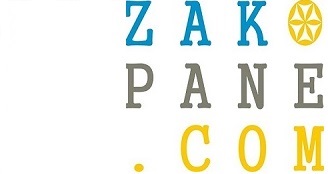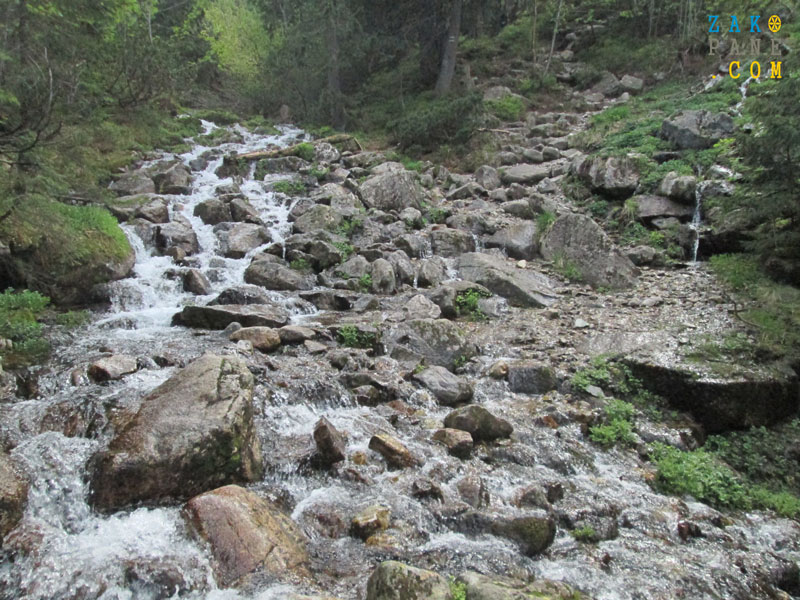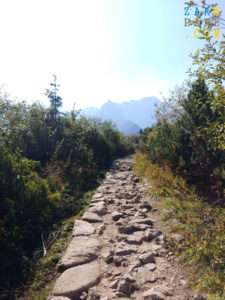It will not be easy!
Seemingly easy trails
Here we write about the routes, which perhaps someone somewhere recommended as trivial, maybe we also have maps with indications of the scale of difficulty and everything seems to be easy and pleasant. And yet, if for the first time we are in the Tatras and if we follow sports only on television, generally we are not sure about our physical condition – let us be careful.
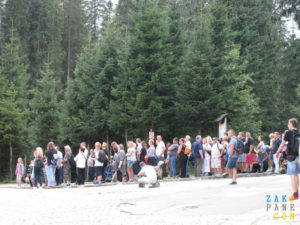
Queue to carts on the road to Morskie Oko. Most of these people probably would not really have the strength to cover the distance about 9 kilometers down. It is worth to remember the carts only go until the dusk. And the last buses leave in the autumn from Palenica Bialczanska at 7:00 pm, from November already at 5:20 pm.
The Morskie Oko, the lake starts the compilation. The asphalt path that leads to it tempts with ease. However, this is a trap. You must drive from Zakopane over 20 km to reach beginning of the asphalt road. Who will not get up at dawn and will not get there around 7 am, will park the car no at Palenica Bialczańska, which is the beginning of the trail, but in Wierchporoniec, for example, dropping the car somewhere along the road and extending the trip with extra miles. In the best case you will find a place at the old border crossing on Lysa Polana, but before that your nerves might be tested while standing in traffic jams. Whoever chooses a bus of private lines leaving the train station, does not care about parking and commutes to the route itself, but this form of transport brings with it certain inconveniences, about which you can read more in the article “Are you going to Giewont?”. The trail itself, when we reach it, is about 9.5 km one way.
Yes, we cannot get to Morskie Oko by bus or private car, let’s repeat it again, because everyday scenes of disappointment take place before the gate with a no-entry ban. So we have about 2.5 hours of walking ahead of us, or maybe even more. The level difference between start of trail and the lake is over about 400 meters. Monotonous walk on the asphalt road can tire you more than overcoming stone stairs on other, even steeper trails. In addition, wandering does not facilitate the fact that sometimes it is extremely crowded there. Of course, the prize is a wonderful lake surrounded by peaks of almost a kilometer tall walls and a shelter with delicious food (the best potato pancakes in this galaxy). For many people, it is also the beginning of the route to Rysy, to Mieguszowiecka Przelecz pod Chlopkiem, Szpiglasowa Przelecz (entrance to the trail is in front of the shelter, as well as the road to Swistowka Roztocka), so they have no way out, they go in the crowd, counting down the minutes to the possibility of breaking into a side trail, into silence and seclusion.
Honestly, if you want to be in the mountains only one or two times during your stay, if you are not sure about your condition – there are several places in the Tatras with also beautiful views which are more accessible and shorter providing even a better chance for a moment of contemplation of the nature in silence. You can easily go there with children and in the event of a sudden change in the weather you can quickly come back. It is worth mentioning here the horse-drawn carts, which evoke many emotions and which for many people seem to be a life-raft on the famous asphalt route. Of course, going uphill, we do not get tired, the horse is tired. But, we are freezing when the temperature in the morning is just a few degrees, even in the summer. Spending an hour curled up on a bench seems to be a worse solution than a quick walk up the hill to warm up. At the end, many people are disappointed, because the carts stop at Polana Wlosienica, from where we still have to walk a bit, just over a kilometer. Who carelessly chose the urban elegant shoes, instead of a backpack has a bag carried in his hand, even this episode, just a bit uphill, can remember for a long time. Many people go here in urban clothing without taking into account the fact that going uphill will quickly regret the heavy jacket, shoulder bags and will have carry all of it. It is not entirely possible to recommend this route to people with children in strollers. Pushing it uphill on steeper sections requires good condition, while going down we will have to hold on to it firmer so that it does not pull us down. For this reason, families with small children usually choose a horse-drawn carriage, carters, of course can take the stroller if it can fit on the cart. There are no more difficulties waiting on the lake itself, but when the snow falls, the situation changes seriously. Already descending the stairs above the surface of water, without crampons, on extremely slippery steps, is simply dangerous, despite ropes and solid handrails.
Dolina Chocholowska (Valley)
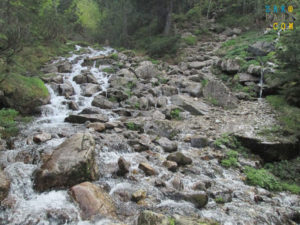
If we can see on the map that a stream runs through the route, we should be prepared when the water is at higher level we will have to cross the extremely slippery stones in the frigid icy water.
More difficult than other valleys due to its length, over 7 km one way. Views the least interesting,although at the bottom of the valley flows a stream. The valley is undergoing a siege in the spring, because everyone wants to see the crocus fields, although they also grow elsewhere, which we write about, for example, in the text dedicated to easy routes. The shelter at the end of the valley is the largest in the Tatras, what takes away its intimate charm. To get to the Chocholowska Valley, we need get off at the Siwa Polana bus stop. From there we can go on foot, the time of going to Polana Chocholowska at the end of the valley is about two hours, although it will probably take more time when we often stop take pictures. You can also cover part of the route by the “Rakon” railway, which runs every half hour and reaches the Polana Huciska, or by bike – there is a bicycle rental on the site and you can ride even further than a tractor train right to the forester’s lodge. Alternatively, we can go by a highlander’s carriage – which can take you to the shelter as well, but then we cannot include such trip to the walks for health and fitness. Attention, when riding a bicycle – the road is quite bumpy.
Giewont, Przelecz pod Kopa Kondracka, Czerwone Wierchy and other trails in the Western Tatras.
It happens that they are neglected because of their location. This is “only” Western Tatras. Yes, of course, if we are healthy, we do not have any problems with a blood circulation, we have no doubts about our physical fitness, we have no fear of exposure, we have a strong will to turn back immediately when we hear the first murmur of a storm – we can go there straight from the train station after arrival to Zakopane, even being in the mountains for the very first time.
However, too often, the TOPR (Tatra emergency service) chronicle records cases of fainting, stumbling, dislocation, and even frostbite – in the Western Tatras – to downplay these local routes. Paradoxically, the High Tatras arouse greater respect and thanks to that, by choosing them, the majority of people are trying to somehow prepare themselves – they have a map, adequate equipment, and enough time adapted to their fitness and strength. In the Western Tatras, it happens differently, we meet often people who are literally empty-handed, even without a bottle of water, in inappropriate shoes, as if they were jumping out of the house for the morning jogging and were planning to return in half an hour. In the Western Tatras, as in the High Tatras, you should never leave the trail, try shorten your path taking short cuts. Why? More on this in the article on the safety in the mountains “How many entrances, so much descents”.
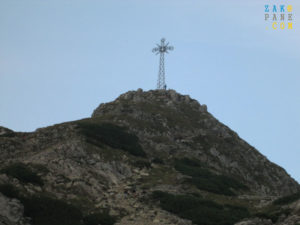
We can see Giewont such deserted only after the season or just before sunset. Usually however you have to add up to 3 hours of waiting to get to the top, there are gigantic queues on the chains. Will our patience keep us in a good mood?
Some tourists plan to take the cable car to the top of Kasprowy Wierch and from there descend down on foot. This is not an easy route. Descent is technically more difficult than going up. Maybe a little less of a burden on the heart, but much easier to get a leg injury, or slipping and a more serious accident if you have not practiced descent technique before.
Anna Markiewicz
